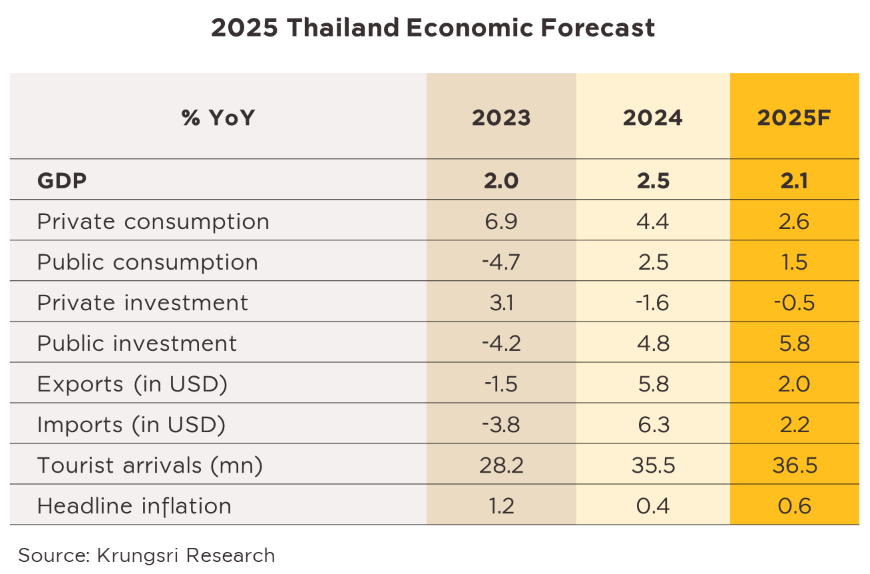Krungsri Research revised down 2025 Thai economic forecast amid compounded risks from uncertain U.S. trade policies and mounting domestic pressures.
Thailand’s Q1 economic figures reflect unsustainable momentum from external demand, while private consumption and investment remain weak.
Although Thailand’s economy expanded by 3.1% YoY in 1Q25—slightly exceeding expectations—its internal structure remains fragile. The 15% export growth was partly driven by front-loading ahead of the U.S. tariff hike, suggesting that external momentum may not be sustainable. Meanwhile, private consumption showed signs of weakening, and private investment continued to contract despite robust growth in public investment. These trends highlight limitations in domestic demand growth and underline ongoing structural challenges.
Krungsri Research forecasts the Thai economy to grow by 2.1% in 2025, constrained by persistent domestic challenges and external uncertainties.
Thailand’s economy is facing mounting pressure from both internal and external factors, particularly the heightened risk surrounding potential US tariff policy, which remains highly uncertain and spans a wide range of scenarios. Compounding these factors are domestic vulnerabilities, including structural problems, uncertain policy effectiveness, and a slow tourism recovery. These challenges are raising downside risks to growth and could become deeply embedded within the Thai economy. We therefore have revised down 2025 GDP forecast due to three key factors: (i) The impact of the earthquake that occurred in late March, (ii) Weakened momentum in the tourism sector, driven by Chinese tourists’ growing concerns over safety while traveling in Thailand, and (iii) Rising risks from the uncertainty of U.S. trade policy. These factors are contributing to a negative feedback loop, dampening confidence in spending and investment.
Krungsri Research expects Thailand’s economy to grow by 2.1% in 2025, down from the previous forecast of 2.7%. The main growth drivers are anticipated to be government spending and economic stimulus measures, alongside a gradual recovery in the tourism sector. Although the rebound in tourism is slower than expected, the number of international visitors is projected to increase from 35.5 million in 2024 to 36.5 million this year. However, the overall outlook for international trade remains highly uncertain due to risks associated with U.S. trade policy. While the U.S. Court of International Trade, as of May 28, 2025 (U.S. time), ordered a suspension of the reciprocal tariff measures, there is still a risk that President Donald Trump could invoke other legal provisions—such as Section 122 of the 1974 Trade Act—to impose additional tariffs of up to 15% on imports from various countries, including Thailand. Given this uncertainty, Thailand’s exports in the second half of the year face tremendous downside risks. The current forecast assumes that the US will impose a 10% tariff on imports from most trading partners, including Thailand. Under this assumption, Thai export growth for the year is expected to slow to just 2.0%, despite a strong double-digit growth in the first quarter. Private consumption is expected to slow to 2.6% in 2025, weighed down by weakening consumer confidence, slowing agricultural income, and persistently high household debt. Furthermore, ongoing uncertainty
surrounding U.S. trade measures and the slow recovery in tourism could affect employment and income. On the investment front, while public investment is projected to grow by 5.8%, it has yet to generate a crowding-in effect to revive private investment. The sluggish tourism rebound has also dampened service-sector expansion, increasing the risk of continued contraction in private investment, which is forecast to shrink by -0.5%. Additionally, uncertainty over U.S. tariff policies continues to erode business confidence, causing firms to delay investment decisions pending greater clarity.
Policy interest rate is expected to be cut 1-2 more times this year. Salient key challenges will be closely monitored.
Regarding the policy interest rate, amid rising international trade risks and signs of a slowdown in the Thai economy during the second half of the year, combined with low inflationary pressures, there is an increased likelihood that the Bank of Thailand may adopt a more accommodative monetary policy stance to support economic recovery. It is expected that the policy rate could be cut one to two more times this year.
Looking ahead, the Thai economy continues to face several critical challenges: (i) elevated risks from U.S. tariff policy, (ii) heightened international political tensions and fragile geopolitical conditions, (iii) uncertainty surrounding domestic economic policy amid limited fiscal space, and (iv) structural issues such as declining manufacturing competitiveness, high household debt, and the rapid transition into an aging society. While many of these external risks are shared globally, the combination with internal pressures could leave Thailand more vulnerable than other countries. Therefore, this is a period that calls for prudent policymaking, coupled with timely and effective responses to navigate the evolving landscape.
